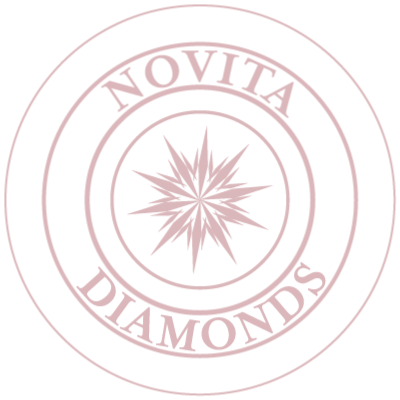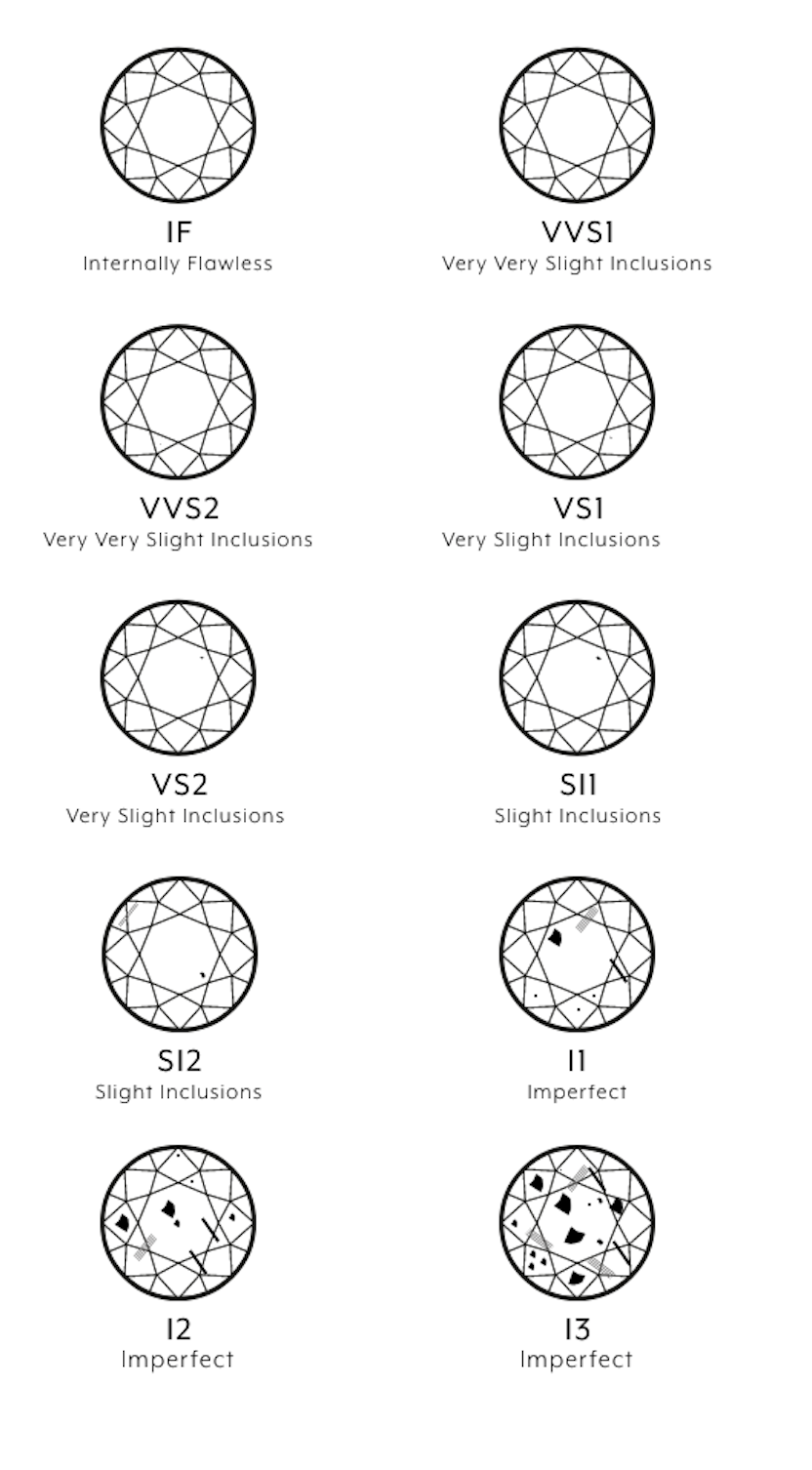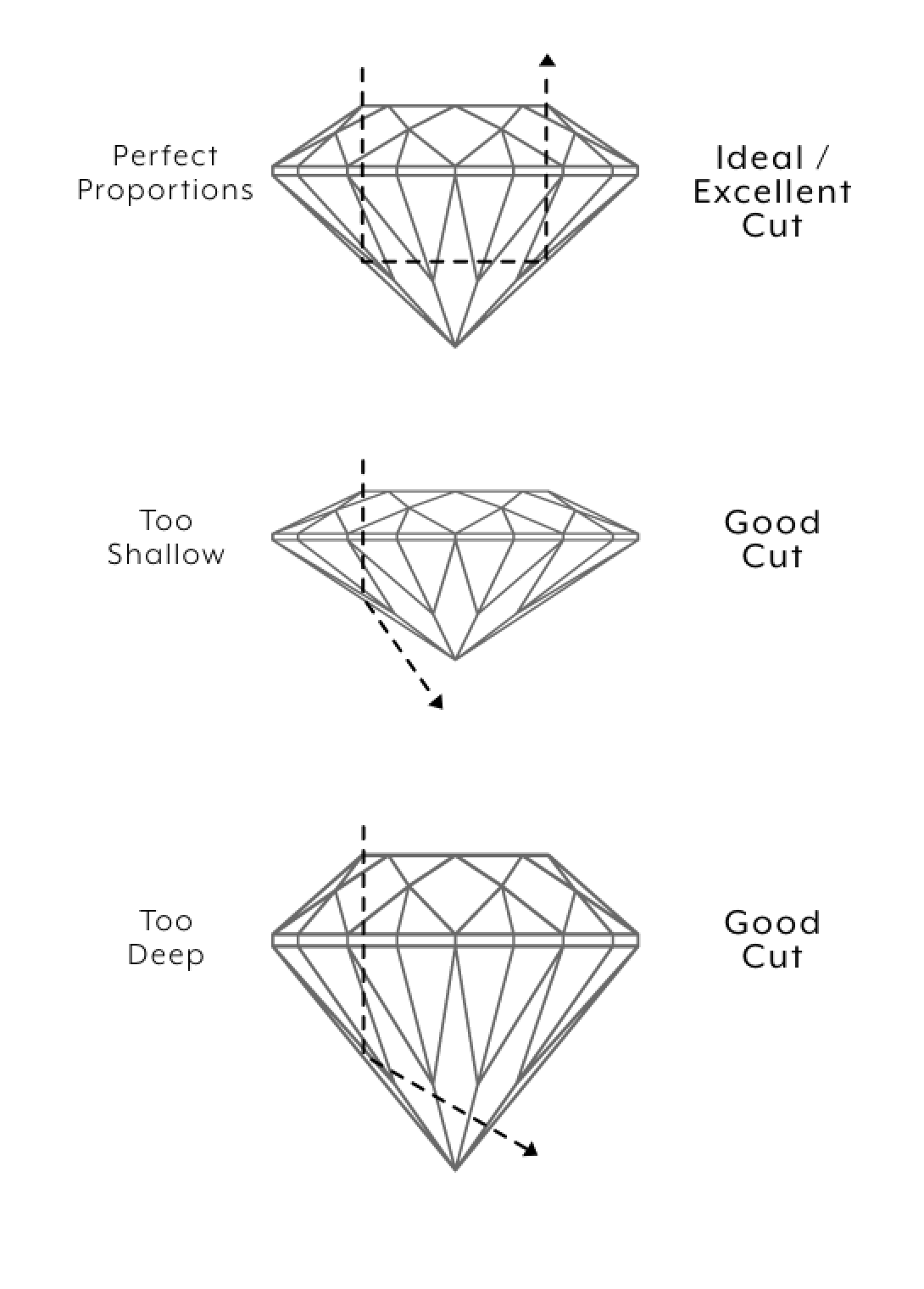BOOK AN APPOINTMENT


Before you purchase your diamond, it is essential to educate yourself on the intricacies of the factors that determine diamond quality. To aid you, therefore, we have put together this guide to help you. A diamond's lustre, sparkle, quality, and price is wholly determined by the 4C's (Cut, Colour, Clarity, and Carat) and learning about them will empower your shopping experience.

Carat
Although Carat and Size can often confuse people, they are not the same thing. Size refers to the measurement of the stone, in millimetres, while Carat, instead of grams, refers to the weight of a diamond
We know the carat unit can be a bit confusing, so we will provide an example. Take two diamonds that are both 1 ct. If the first one is cut very deep, it will look closer to a 0.80ct stone than an average 1ct one. If the second one is instead cut very shallow, the size of the diamond may look closer to a 1.25ct stone at the expense of its quality. Therefore, a 1ct diamond that looks good will also weigh 1ct.
When diamonds are cut too deep or too shallow, quality is always compromised, resulting in the diamond not reaching its full brilliance, and in some cases, looking dark or lifeless in the centre.
Clarity
Clarity, the first of the 4 Cs, refers to the diamond's 'clearness'. The Clarity grades determine how many or how few imperfections (known as inclusions).
The Clarity grades, according to GIA, are as follows:
The highest grade a diamond can get when it comes to clarity. Flawless (FL) and Internally Flawless (IF) diamonds have no visible inclusions inside the stone when viewed through 10x magnification. However, unlike Flawless (FL) diamonds, Internally Flawless (IF) diamonds may have some surface marks (blemishes) under 10x magnification.
VVS1 and VVS2 are the next highest clarity grades. Although a lower tier than FL and IL, the very tiny inclusions in VVS1 and VVS2 diamonds are incredibly difficult, even to gemologists and diamond experts, to see under 10x magnification. Pinpoints, needles, or internal graining could be some of the inclusions that may be present in a VVS diamond.
Although lower in grade than VVS1 and VVS2, VS1 and VS2 grade diamonds are still eye-clean. VS1 and VS2 clarity diamonds have slightly larger inclusions than the VVS range. The inclusions are difficult to see in (VS1) but somewhat easier to spot in (VS2) if looked through 10x magnification. VS diamond's inclusions include crystals, cavities, or clouds.
SI1 and SI2 clarity diamonds have more prominent inclusions than the VS diamonds. To the trained eye, these inclusions are noticeably visible under 10x magnification. SI diamond might have inclusions are chips, knots, and feathers.
I1-I3 clarity diamonds are the bottom grade in clarity. They have much more pronounced inclusions that are easily noticeable to the naked eye. Large inclusions like the ones found in I clarity might affect the brilliance of the diamond.
Novita Diamonds recommend you get the finest looking diamond your budget allows. To ensure that the inclusions in the diamond are not visible to the naked eye, even when looked closely, we recommend IF, VVS1, VVS2, VS1, VS2 and SI1 as they all have inclusions not visible to the naked eye.
Clarity


Colour
Out of all the 4Cs, Colour is the most straightforward. A Diamond Colour grade is a measure of how colourless the stone is. The best diamonds are the ones without any colour in them, allowing their brilliance to shine through. The whiter or, to be precise, the clearer the stone is, the more valuable it becomes. As the colour grade lowers, tints of other colours, such as yellow or brown, start to be become noticeable, decreasing their overall value. The diamond colour grades by GIA goes from D (colourless) to Z (light yellow or brown). The grades are usually separated by different tiers for simplification since diamonds with a 1 or 2 colour grade difference may look very similar to the untrained eye.


D,E,F (colourless)
What are D-F grade diamonds? They comprise the highest grade of Colour and also the rarest. Being colourless, D and F diamonds are extremely clear and bright and have no yellow or brown tints whatsoever. D and F are grouped as colourless since when placed in a setting, they will both look the same, at least to an untrained eye. To differentiate between a D diamond and one that is F, both stones must be loose and compared to each other on a pure white background.
G,H (near colourless)
What are G-H grade diamonds? Almost as good as D and F, G-H are grouped together as near colourless. Although they have a very faint tint of Colour, in practice, it is not very noticeable at all to the naked eye. When in a setting, they will appear more or less white and still look colourless. Only when loose and compared to colourless diamonds, however, will the very slight tint in the stones be noticeable.
I,J (very faint Colour)
What are I-J grade diamonds? More common and of lower quality than the previous two tiers, they are grouped together as having a very faint colour. When compared to diamonds in the colourless or near colourless categories, I-J diamonds have a slightly more noticeable yellow, brown or grey tint. Anything lower than a J colour will have a significantly more noticeable yellow, brown or grey tint in the diamond.
Recommended by Novita: Since D-F colour diamonds are all very clear and colourless, they look very similar to each other to the untrained eye; therefore, there aren't any pressing reasons to pick a D coloured diamond over an E or F, other than personal choice. As long as the colour of the diamond is F or above, more of the budget can be allocated to get a better diamond cut and shape.
Despite their relative affordability and plentifulness, G-H colour diamonds are a very good choice as they are near colourless, making them a good "budget stone". With the considerable savings by going for G-H diamonds, getting a much larger stone is possible that wouldn’t have been otherwise possible when purchasing a D-F coloured diamond.
Recommended by Novita:
Safe money or get a bigger stone by going for diamonds D-G in Colour.
Cut
The last, but the most important, of the 4 Cs of diamonds is the Cut grade. The importance of a good Cut cannot be understated since it has the most significant effect on a diamond’s appearance. The sparkle, fire, and brilliance that are all qualities associated with diamonds are all dependent on the Cut. If a diamond is not well proportioned, i.e., if it is cut too deep or too shallow, it will result in the light, which enters the stone, leaking out of the bottom of the diamond. Light entering a diamond should bounce back up and not leak out the bottom or the sides, thereby rendering the diamond dull and lifeless. Diamonds that are cut properly are brilliant in appearance. The light that enters a well-cut diamond reflects off all the sides, or the facets, of the diamond, come straight back up, imparting in the diamond a scintillating and otherworldly appearance. The Cut is so important, in fact, that even a diamond of extremely high quality in every other category can still look dull and lifeless if its cut grade is not high enough.
Recommended by Novita: Always, without exception, go for a diamond with an Ideal Cut or Excellent Cut.

Novita Diamonds Guidance:
Our showroom options have been individually hand-picked by our expert gemmologists to ensure that we only have the best quality diamonds available for you to view at your appointment and to purchase online. Our gemmologists sort through available diamonds and only choose the best diamonds in each colour and clarity category. We highly recommend our customers come into our showrooms to have further guidance on selecting the best stones for you or your loved ones.
When on our Novita website, remember that you can filter diamonds to your liking by the diamond 4Cs category, as shown in the image below.

You can further filter the available diamonds in our showroom by clicking on the 'AVAILABLE IN SHOWROOM' tab and checking its availability in the 'SHOWROOM' column.
 FAQ'S
FAQ'SUndoubtedly, lab grown diamonds are genuine diamonds. They are created through the same chemical reactions and physical processes that occur naturally within the Earth, but in a controlled laboratory environment. This process involves the gradual accumulation of carbon atoms around a diamond crystal, increasing its size. Lab made diamonds are chemically, physically, and optically identical to natural diamonds, thus scientifically recognized as real diamonds. Both IGI and GIA, the leading authorities on diamonds, grade lab diamonds using the same scale and methodologies as mined diamonds. For more information, you can explore our about lab diamonds page.
Lab grown diamonds are considerably more affordable
than mined diamonds. The price difference varies depending on factors such as size, quality, and type,
but typically, lab made diamonds are about 75% less expensive than natural diamonds. The reason
for this is that the cost of producing rough laboratory grown diamonds is much lower than that of mining
and removing rough natural diamonds from the earth. However, to become retail-ready, a rough diamond must
go through all the same processes, including cutting, polishing, and certification, regardless if it is
mined or lab grown diamonds; they undergo the same processes.
To point up the significant savings you can expect, consider this example: If a mined diamond costs S$ 10,000,
a comparable lab grown diamond would only cost around S$ 2,500. This price difference highlights how buying a
lab grown diamond over a mined one can be done without braking the bank.
Yes they do when being tested with a diamond tester. All lab grown diamonds are tested using the same methods as natural diamonds; there are no differences between two. Diamonds, whether they are mined or made, possess a variety of unique properties, including hardness, refractive index, and thermal conductivity. Lab made diamonds are chemically, physically, and optically identical to natural diamonds, so they will exhibit the same properties and characteristics when tested.
Just as in natural diamonds, inclusions are also present in most lab diamonds. Inclusions are natural imperfections that are found within diamonds, and they can occur in both lab and natural diamonds. Inclusions can take many forms, such as tiny bubbles or carbon deposits trapped inside the diamond as it formed. Just like natural diamonds, most diamonds created in labs have flaws, and only very few become flawless. Check out our guide to the 4Cs for more information about diamond clarity.
Yes insurers will insure lab made diamond rings the same way they would mined diamond rings, because are treated exactly the same as mined diamonds. When you visit us you can ask our team for guidance they will be happy to assist you. Keep in mind, your insurance policy will typically cover the cost of replacing or repairing your item if it is lost, stolen, or damaged. Make sure you read the terms of your insurance policy carefully, so you know what it covers and what it does not.